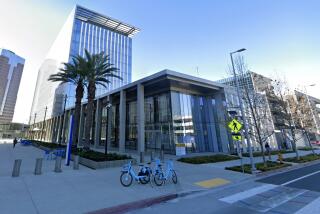DWP still struggling with fallout from billing fiasco
Lois Gass didn’t realize it at the time, but when she and thousands of other Los Angeles residents saw their utility bills suddenly rocket out of control, her anger helped set off one of the biggest scandals to befall the Department of Water and Power.
One day in late 2013, Gass got a call from her bank to say that her automatic payment account was overdrawn; the DWP, it turned out, had wrongly charged her $3,900, 12 times her normal electricity bill. When she called the utility to complain, so many other customers were jamming the lines that she was put on hold for an hour — then disconnected.
“The whole thing was outrageous,” Gass, 70, said last week. “I live on a budget and small pension. How do you trust that it won’t happen again?”
About a year and a half later, the consequences of a DWP decision to launch a computer system that spit out thousands of inaccurate bills are still playing out. So far, the scandal has seen the resignation of the DWP’s then-chief executive, Ron Nichols — although he said the billing debacle had nothing to do with his departure — three class-action consumer lawsuits and another against the vendor who helped launch the system.
Last week, California State Auditor Elaine M. Howle produced a detailed reconstruction of events. She suggested that at least some of the $230-million cost could be passed on to customers in the form of higher utility rates — an outcome that could make it even more difficult for the utility to regain the public’s trust.
On Tuesday, City Councilman Felipe Fuentes called for the auditor to present her findings directly to the council and have the city’s independent Ratepayer Advocate add its own analysis.
“It is critical that the LADWP continues to accept responsibility,” Fuentes said, “and give the ratepayers the answers they deserve about the botched and the costly rollout.”
Howle’s report shed new light on how the billing problems cascaded as managers scrambled and the City Council joined the drama:
•The audit found that DWP officials knew the computer system was flawed but launched it anyway.
Reports from its own quality assurance expert warned that the project’s scope, quality and schedule were at the lowest possible rating and needed immediate attention. An internal DWP investigation made the same conclusion, finding “overwhelming evidence” that the budget and time frame provided to integrate two dozen outdated computer programs, some nearly 40 years old, was unrealistic.
Austin, Texas-based TMG Consulting, brought in by new DWP chief Marcie Edwards, also blamed the “inexperience” of PricewaterhouseCoopers, the vendor hired to help set up the system. Last week, City Atty. Mike Feuer announced that the city was suing PricewaterhouseCoopers, alleging that it misled the DWP’s executive team about its ability to manage a complex utility billing system.
•In trying to stem the flood of complaints once the system was churning out inaccurate charges, DWP managers took steps that ended up creating more problems.
After the Customer Care and Billing program went live in September 2013, utility complaint lines were deluged with calls that resulted in long waits that angered customers even more. To lower the number of calls, managers decided to send out fewer late payment notices, allowing customers to accumulate $1,000 in unpaid bills — instead of the usual $250 — before a collections process was started. Complaints indeed declined, but the decision not to collect overdue bills increased the utility’s debt by hundreds of millions of dollars.
Howle, the state auditor, wrote that the utility “may ultimately have to write off millions of dollars of past due bills as bad debt,” because statistics show the longer a charge goes unpaid, the less chance it will ever be paid.
Auditors reported that as of November 2014, the DWP’s customer debt ballooned to $681 million, about $245 million more than normal for a utility that sees about $5.6 billion in customer revenues each year. That means the write-off from the billing fiasco could reach $11 million to $43 million. DWP spokesman Joseph Ramallo said managers knew at the time that the write-off rate would probably climb and have developed a long-term plan to gradually collect unpaid bills.
Edwards, appointed chief executive by Mayor Eric Garcetti in January 2014, brought on 200 new customer service operators and meter readers. Auditors say that by last November, the DWP had built its staff to about 420 call center representatives. Call waiting times have declined from an average high of 37 minutes to less than 5.
•When council members reacted to constituents’ calls for help, they publicly grilled utility executives and demanded a moratorium on service disconnections. That moratorium further delayed the collection of unpaid bills until it was lifted a few months later.
Councilman Mitchell Englander, who called for the suspension, is unapologetic.
“When you have people who are in fear of losing their homes, that’s the cost that whoever is liable should have to pay,” Englander said last week. “The responsible parties are not the ratepayers.”
The person mostly on the hot seat at one council hearing was then-general manager Nichols, who “seemed unable to soundly defend the department’s decision to launch” the computer billing system, Howle’s audit said. The manager’s only response at the time was “There comes a point — after dress rehearsals and testing — that you simply have to go live to know in a real working environment exactly how the system works.’”
Nichols, now an executive with Southern California Edison, said last week that the DWP project team had spent long hours over the summer of 2013 trying to refine the system as best they could. The launch had already been delayed three times.
“There was only so much continued effort before we ran into serious fatigue of our people,” Nichols said. “We made the decision to go forward.”
Nichols said he now recognizes that the system had a flaw that caused many bills to be based on a customer’s estimated usage — a calculation allowed when a DWP worker cannot reach a meter because a fence is locked or a dog is present. Managers had expected 5% of the bills to be estimated, but the computer churned out 20%.
“If I had known that, I wouldn’t have gone ahead,” he said.
The whole episode doesn’t bode well as other city departments prepare to upgrade their own outdated computer systems, Englander said. For whatever reason, he said, government seems to struggle with technology.
“This,” he concluded, “was a very expensive and valuable lesson.”
Gass said she learned a lesson as well. Although her charges were eventually straightened out, the experience was so upsetting that she no longer pays her electric bill automatically and now scours every statement for accuracy.
catherine.saillant@latimes.com
Follow @cssaillant2 on Twitter for more news from L.A. City Hall.
More to Read
Sign up for Essential California
The most important California stories and recommendations in your inbox every morning.
You may occasionally receive promotional content from the Los Angeles Times.











